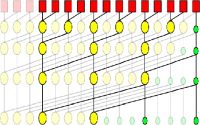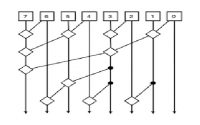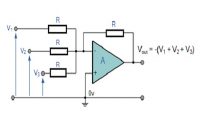What is PMMC Instrument : Construction & Its Working
There are different electrical machines are used in the ship so that it can travel from place to another safely as well as capably. But these machines need maintenance while traveling to avoid any type of breakdown. To measure different electrical parameters on the ship, different instruments are used so that we can check the machines to maintain their proper working condition. Similarly, an instrument like PMMC (permanent magnet moving coil) is frequently used on ships as well as different applications. This instrument can be categorized into two types like Galvanometer & D’alvanometer. This article discusses an overview of the PMMC instrument.
What is a PMMC Instrument?
The term PMMC is the short form of “permanent magnet moving coil”. This instrument is simple as well as most frequently used on ships with sophisticated names. These instruments are used when an exact measurement is required as well as to aid while maintaining electrical equipment. Apart from PMMC, it is also called as D’alvanometer. It is a kind of galvanometer that works on the principle of D’Arsonval.
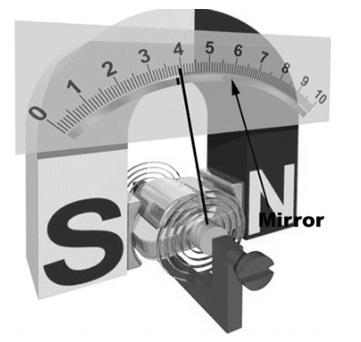
These instruments use permanent magnets to create the stationary magnetic field in the coils, and then it is used with the moving coil that is connected to the electric source for generating deflection torque according to the Fleming left-hand rule theory.
The PMMC instrument working principle is when the torque is applied to the moving coil that is placed within the permanent magnet field, and then it gives a precise result for DC measurement.
Working Principle of a PMMC Instrument
Whenever a current caring conductor is located within a magnetic field, then it experiences a force that is perpendicular to the current & the field. Based on the rule of “Fleming left hand”, if the thumbnail of the left hand, middle and forefinger are at 90 degrees with each other.
After that the magnetic field will be in the forefinger, flow of current will be across the middle finger and finally, the force will be through the thumb finger.
Once the current flow within the coil on the aluminum former, the magnetic field can be generated in the coil in proportion to the current flow.
The electromagnetic force throughout the fixed magnetic field from the permanent magnet generates the deflection force within the coil. After that the spring generates the force to resist additional deflection; therefore it helps to balance the pointer.
So damping force can be generated within the system through the aluminum core movement of the magnetic field. It maintains the pointer stable to a point. Once it attains equilibrium by controlling & deflection torque to provide accuracy in measurement.
PMMC Instrument Construction
The construction of the PMCC instrument can be done using several parts where the permanent magnet and moving coils are essential parts. Each part of this instrument is discussed below.
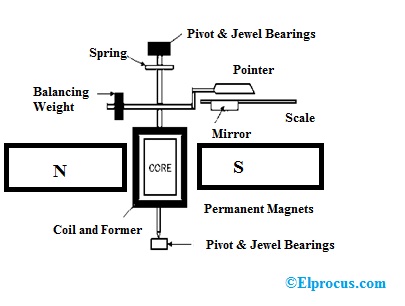
Moving Coil
It is an essential component of the PMMC instrument. The designing of this coil can be done by wounding copper coils to a rectangular block among the magnetic poles. It is made with Aluminum and the rectangular block can be called Aluminum former rotated into the jeweled bearing. So it permits the coil to turn freely.
Once the current is supplied throughout these coils, then it gets a deflection within the field, then it is used to find out the voltage or current magnitude. The aluminum is a non-metallic former, used to measure the current whereas the metallic former including high electromagnetic damping is used to calculate the voltage.
Magnet System
The PMMC instrument includes two high-intensity magnets otherwise a ‘U’ shaped magnet-based design. The designing of these magnets can be done with Alnico & Alcomax for higher superior field intensity & coercive force. In several designs, an extra soft iron cylinder can be arranged among the magnetic poles to create the field identical; while decreasing air reluctance for increasing the strength of the field.
Control
In the PMMC device, the torque can be controlled due to the springs which are fabricated with phosphorous bronze. These springs are arranged among the two jewel bearings. The spring provides the lane to the lead current to supply in & out of the moving coil. The torque can be controlled mainly due to the delay of the ribbon.
Damping Torque
Damping torque can be generated within the PMMC instrument using the aluminum core’s movement within the magnetic field.
So the pointer can be kept at rest after the early deflection. It assists in the right measurement devoid of fluctuations. Because of the movement of the coil within the magnetic field, eddy current can be generated within the aluminum former. This generates the damping force otherwise torque to resist the motion of the coil. Gradually the deflection of the pointer will be reduced and lastly, it will stop at a permanent position.
Pointer and Scale
In this instrument, the connection of the pointer can be done through the moving coil. It notices the moving coil’s deflection. The magnitude of their derivation can be displayed on the scale. The pointer within the instrument can be designed with lightweight material. Thus, it can be simply deflected through the coil’s movement. Sometimes, the parallax error can occur within the device which is simply decreased by properly arranging the pointer’s blade.
What are the Different Reasons that Cause an Error in PMMC?
In a PMMC instrument, different errors can be occurred due to the temperature effects as well as getting older of the instruments. The errors can be caused by the main parts of the instrument like the magnet, effect of temperature, moving coil and the spring.
So, these errors can be reduced when the swamping resistance is connected in series using the moving coil. Here, the swamping resistance is nothing but the resistor which includes less temperature coefficient. This resistance can reduce the temperature effect on the moving coil.
Torque Equation
The equation involved in the PMCC instrument is the torque equation. The deflecting torque induces due to the coil’s movement and this can be expressed with the equation shown below.
Td = NBLdl
Where,
‘N’ is the no. of turns in the coil
‘B’ is the density of flux within the air gap
‘L’ & ’d’ are vertical as well as horizontal lengths of the surface
‘I’ is the flow of current in the coil
G = NBLd
The restoring torque can be provided to the moving coil can be done with the spring and it can be expressed as
Tc = Kθ (‘K’ is the spring constant)
Final deflection can be done through the equation Tc = Td
Substitute the values of Tc & Td in the above equation, then we can get
Kθ = NBLdl
We know that G = NBLd
Kθ = Gl
θ= Gl/K
I = (K/G) θ
From the above equation, we can conclude that the deflection torque can be directly proportional to the flow of current in the coil.
Advantages of PMMC Instrument
The advantages are
- The scale in the instrument can be divided properly
- It generates no losses because of hysteresis.
- It uses less power
- It is not influenced by the stray magnetic field.
- High accuracy
- It is used as a voltmeter/ammeter with appropriate resistance.
- This instrument can measure the voltage & current with different ranges
- This instrument uses shelf shielding magnet so it is applicable in aerospace
Disadvantages of PMMC Instrument
The disadvantages are
- It works with only DC
- It is expensive compare with other alternative instruments
- It is delicate
- It shows an error because of the magnetism loss in permanent magnet
Applications of PMMC Instrument
The applications are
FAQs
1). What is the function of the PMMC instrument?
It is used to measure the current & DC voltage
2). Why PMMC does not use AC?
These instruments measure the average value and the value of AC is zero. The pointer of this meter doesn’t move.
3). What is the working principle of PMMC?
It works on the principle of electromagnetic effect
4). What is deflecting torque?
The torque that turns aside the pointer over a scale based on the flow of current throughout the instrument.
Thus, this is all about an overview of the PMMC instrument. These instruments are best in measuring the DC & voltage. These are sensitive, accurate and these instruments work for a long time without maintenance and defects. Here is a question for you, what are the alternative names of the PMMC instrument?


